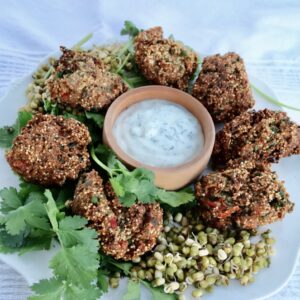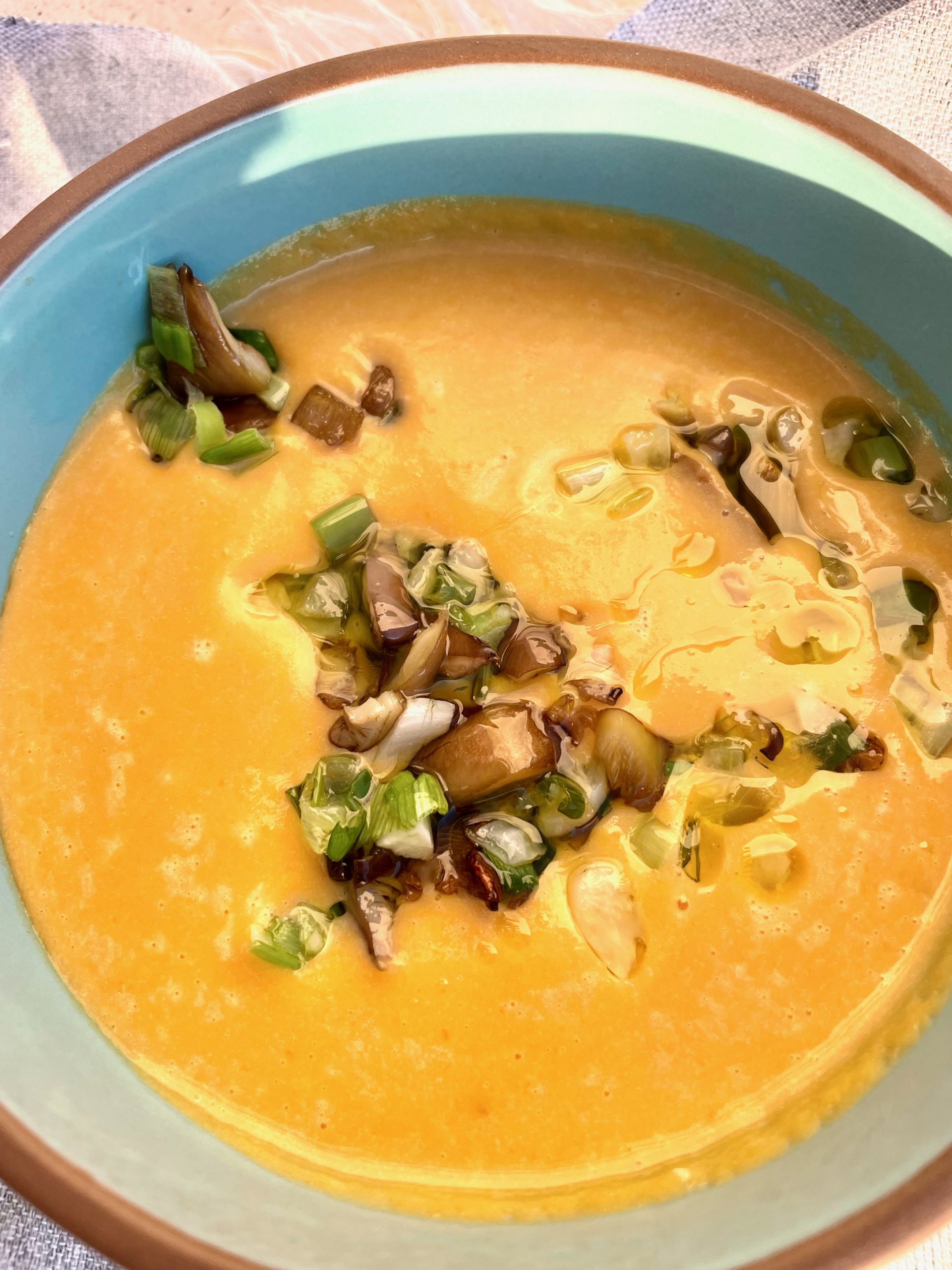

Vegan Meatballs or Crispy Vegan Puffs
Equipment
- 1 bowl
- 1 3 c size stainless pan for deep frying
Ingredients
- 1 cup mung beans sprouted to 1/2 in tails, then 1 cup reserved for salads (Use remaining sprouts in recipe)
- Mung Bean Alternative: 1 1/2 c dried lentils sprouted and prepared in the same way
- 1/2 c flax seeds
- 1/2 c dry amaranth cooked, or 1/2 c pre-popped amaranth cereal
- 1 small leek or green onions (1/4 c greens 1/4 c onion part
- 2 small red sweet peppers very finely diced (1/3 – 1/2 c)
- 1 small handful spinach (optional) finely diced
- 1 small handful parsley finely diced
- 1 small handful cilantro finely diced
- 2-3 T garbanzo flour or 1/2 c vegan dry white bread crumbs gluten-free
- 1/2 t baking soda
Instructions
- Steps:1. THREE – FOUR DAYS AHEAD OF TIME soak mung beans overnight2. Drain mung beans after a day, then rinse and put in a mesh colander on the counter to sprout. Cover with a towel.3. Rinse mung beans with a spray of water daily and recover with the towel until the beans have a 1 in tail. Reserve in a sealed glass container for up to 4 days more if desired. 4. Add all but 1 cup of the sprouted mung beans to the blender (about 2 1/4 c) with 1/4 c water. Blend well. 5. Add 1/2 c of flax seed to mung beans in a bowl and mix well. Let sit 30 minutes.6. Cook 1/2 c amaranth in 1 c water, uncovered, adding more water by 2 T increments if needed (another 1/4 c water can be added). Amaranth should be cooked through but not overly sticky like some amaranth porridges can be.7. Meanwhile sauté 1 small leek or giant green onion (1/4 c of greens part and 1/4 c of onion part) in 2 T olive oil with 2 small red sweet peppers, finely dice onion and pepper.8. Once onion and pepper are softened add 1/4 t cumin seeds and bloom. 9. Turn heat off and add 1 generous teaspoon coriander to the mixture in the pan. 10. Chop a handful of spinach, parsley and cilantro (equal amounts of each). A fine chop should yield a 1/2 – 3/4 c of greens. Before chopping it will appear to be 1 1/2 c of greens. You can change the proportions if desired (ie if no spinach, use more parsley).11. After the mung bean and ground flax seed have sat for 30-45 minutes, add 1/2 t baking soda and 1/2 t baking powder. Stir in all the other ingredients, including all but 2 T of the cooked amaranth**12. Heat 1 cup expeller pressed coconut oil in a small 1 pint (3 cup) size saucepan. A tiny saucepan is best for deep frying because it conserves oil, a precious commodity. Plan to fry each puff for 2 minutes, one at a time and do other kitchen work at the same time. Individual frying also works well because it keeps the oil at a more constant temperature than would occur in a large pan adding many puffs at a time. A hot, but not too hot temperature is important to prevent the puffs from absorbing oil and being mushy. They should be crispy on the outside with the amaranth grains all over the surface. 13. Right before frying, quickly stir in baking soda 1/2 c vegan white dry white bread crumbs or 2-3 T garbanzo flour. Determine the amount of flour/crumbs your mixture needs by doing a test fry.14. Deep fry for 2 minutes large spoonfuls (1 1/2 T in volume) by dropping off the edge of a large wooden spoon. The oil should bubble and froth a great deal. After 1 minute 30 seconds, you may need to gently loose the bottom of your puff from the pan with a metal spoon. 15. Let continue to fry until it floats in the oil and it is dark golden brown all over. Flax imparts a dark color to baked/fried goods. 16. Drain on paper towels or an old tea towel.
Notes

What foods are the best to eat to meet my protein needs?
While the association of protein with meat is common, it’s essential to dispel this misconception, as nearly all foods (in the form they grew in) contain some level of protein. Vegetables, when combined with grains, offer a comprehensive amino acid profile, a principle that extends to various food combinations. By broadening the definition of protein beyond meat to its true essence of “amino acids,” one can approach the concept of “getting enough protein” more comprehensively. In reality, a day’s worth of protein requirements can be met with servings of nuts, beans, vegetables, and grains, without incurring the potential negative effects associated with a meat-heavy diet. You can absolutely obtain sufficient protein with a vegan diet.
An intake of protein beyond the body’s requirements results in the removal of nitrogen or ammonia, which is then converted to urea by the kidneys and excreted. This process leaves the carbon chain to be transformed into fat. As you can observe, a greater protein intake taxes the body by creating more work and excretion. Notably, the kidneys, already burdened with a 50% greater workload during pregnancy, can be strained by an excess of protein. It is imperative to strike a delicate balance in the level of your protein consumption….if you are consuming a diet of primarily meat, you’re going into ketosis, bro. More likely you are taxing your organs, contributing to your aging, raising your cortisol levels, and increasing the likelihood of developing hypertension, or if you are too healthy for that to happen, in the minimum you are damaging your blood vessels.
Moreover, elevated meat consumption, as prevalent in various paleo diets, introduce potential concerns, including heightened LDL levels and diminished HDL levels associated with hypertension and cardiovascular issues {Castelli, 1984 #114}. The intricate interplay extends to homocysteine, revealing positive correlations with elevated LDL cholesterol and negative associations with HDL cholesterol, as observed in myocardial infarction cases {Qujeq, 2001 #249}. Furthermore, processed meat, red meat, and poultry consumption aligns with an increased risk of cardiovascular disease {Zhong, 2020 #115}, underscoring the impact of dietary choices on overall health, particularly during pregnancy.
Dietary patterns linked to disease, be it from excessive meat intake or consumption of a high glycemic or refined Omega-6 oil-rich diets, can exert adverse effects on pregnancy. The detrimental impact of daily meat consumption on blood vessels and inflammation poses a significant concern for pregnant women. Notably, high animal protein consumption undeniably elevates homocysteine levels, a factor linked to lower intelligence levels of the baby if they occur during pregnancy {Srinivasan, 2017 #117} {Mishra, 2020 #116}. This intelligence deficit is not exclusive to high meat diets; it also surfaces in veganism due to inadequate bioavailable B12, though this can be partially masked by sufficient iron and folate in cases of microcytic anemia. The spectrum of high homocysteine levels encompasses both high meat and vegan diets, with different causative factors within the same metabolic pathway.
In light of these considerations, an omnivorous diet, emphasizing abundant leafy greens, legumes, ample eggs, and judicious meat consumption, emerges as a prudent choice for regulating homocysteine levels. The inclusion of B6 from whole grains in this dietary approach contributes to maintaining balance in the one-carbon metabolic cycle and mitigating inflammation. Conversely, keto or paleo diets, by removing high B6 foods, may inadvertently elevate inflammation levels.
Omnivores with restrained meat consumption, incorporating B12-rich foods like eggs, fermented dairy, and seafood within a plant-centric diet, exhibit healthier homocysteine levels compared to those on high meat diets. Scientific evidence underscores the safety and health benefits of deriving most protein from plant sources during pregnancy {{, 2020 #253}}. While B12 supplementation is an option, incorporating real food sources, as practiced in vegetarianism during pregnancy and breastfeeding, is considered optimal.

Castelli, W. P. (1984). “Epidemiology of coronary heart disease: the Framingham study.” Am J Med 76(2a): 4-12.







